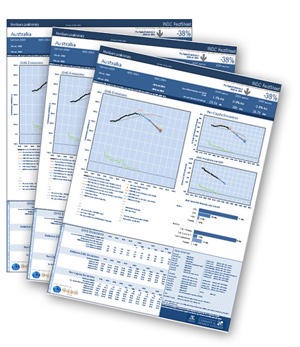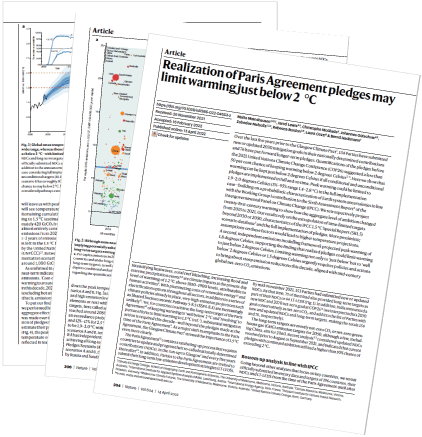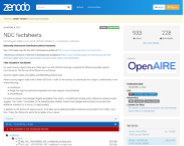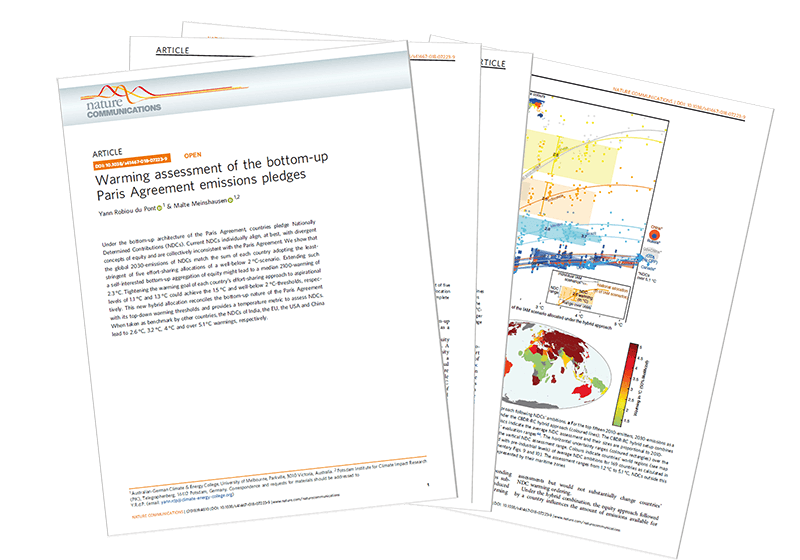Country:
Graphic showing the country's ambition (as global warming alignment) corresponding to its possible emissions levels in 2030 (expressed as percentage to 2010 levels). The country's ambition, in terms of global warming alignment, is determined by the position of the emissions level of its NDC. The graph (and the 'custom pledge' function below) can be used to assess the ambition level of potential 2030 emissions targets.
The warming assessment of countries’ pledges reflect the warming expected in 2100 with only a median (>50%) likelihood, compared to pre-industrial levels. The underlying emissions scenarios may therefore result in a temporary overshoot of the warming assessment. The countries’ warming assessments presented here should therefore be considered as a minimum to achieve a warming goal, and countries’ pledges in line only with a 2 °C warming are therefore not be consistent with the Paris Agreement goals. Only countries with pledges leading to a 2100-warming below 1.5 °C could be in line with the Paris Agreement goals of ‘holding the increase in the global average temperature to well below 2 °C above pre-industrial levels and pursuing efforts to limit the temperature increase to 1.5 °C’.
The relationship between the 2100 global warming and the national 2030-emissions relies on a range of global emissions scenarios. The underlying global emissions scenarios and methods are available here.
Emissions from land use (LULUCF emissions) are not included since no universal accounting method of positive or negative LULUCF emissions is currently in place and since they are not considered by all parties as part of the emissions scope to be negotiated.
Emissions trajectories to stay below 2°C and 1.5°C
The national emissions scenarios provided here result from the hybrid allocation where each country uses the least-stringent of three equity allocations (historical responsibility, capability or equality) applied to a 2°C-scenario and 1.5°C-scenario. The 2°C-scenario features a likely (>66%) chance to stay below 2°C over the century and a median (>50%) chance to be below 1.7°C in 2100. The 1.5°C-scenario features a median chance to be below 1.5°C in 2100 and allow a potential overshoot of 1.5°C before. Securing a likely chance to stay below 1.5°C of warming requires greater mitigation efforts, compared to the trajectories presented here. The underlying global emissions scenarios and methods are available here.
The 2030-values of these national emissions trajectories may differ from the values provided in the first graphic above, which relies on a range of global emissions scenarios. This difference illustrate the difference in the underlying assumptions of global emissions scenarios that feature a range of 2030-emissions values for a given global warming response (more details here and here).
Emissions from land use (LULUCF emissions) are not included since no universal accounting method of positive or negative LULUCF emissions is currently in place and since they are not considered by all parties as part of the emissions scope to be negotiated.
Fairness statement contained in NDC
UNFCC status
Submission date
6. How the Party considers that its nationally determined contribution is fair and ambitious in the light of its national circumstances
(a) How the Party considers that its nationally determined contribution is fair and ambitious in the light of its national circumstances
(b) Fairness considerations, including reflecting on equity;
(c) How the Party has addressed Article 4, paragraph 3, of the Paris Agreement;
(d) How the Party has addressed Article 4, paragraph 4, of the Paris Agreement
(e) Not applicable, as applicable only to LDCs and Small Island Developing States
7. How the Party considers that its nationally determined contribution is fair and ambitious in the light of its national circumstances
(a) How the nationally determined contribution contributes towards achieving the objective of the Convention as set out in its Article 2
(b) How the nationally determined contribution contributes towards Article 2, paragraph 1(a), and Article 4, paragraph 1, of the Paris Agreement.
Conditionality of NDC
Other comments
Latest available target in 04/2022
Source
Note
Fairness statement downloaded on October 28th 2016 from:
WRI, CAIT Climate Data Explorer. 2016. CAIT Paris Contributions Map. Washington, DC: World Resources Institute. (http://cait.wri.org/indcs/).
The original
NDCs and
NDCs submitted so far are hosted on the UNFCCC website.
2100-warming in °C
The warming assessment of countries’ pledges reflect the warming expected in 2100 with only a median (>50%) likelihood, compared to pre-industrial levels. The underlying emissions scenarios may therefore result in a temporary overshoot of the warming assessment. The countries’ warming assessments presented here should therefore be considered as a minimum to achieve a warming goal, and countries’ pledges in line only with a 2 °C warming are therefore not be consistent with the Paris Agreement goals.
On the ‘Pledged Warming Map’, only countries with pledges leading to a 2100-warming below 1.5 °C could be in line with the Paris Agreement goals of ‘holding the increase in the global average temperature to well below 2 °C above pre-industrial levels and pursuing efforts to limit the temperature increase to 1.5 °C’.
Data sources for the quantification of emissions expected to results from countries’ emissions targets (NDCs)
Latest update: November 5th, 2022.
Original NDCs
The quantification of the first Nationally Determined Contributions – or NDCs – used here is detailed in ‘Factsheets’ for all countries under high or low ambition estimates. The current national commitments for 2030 add up to a global level of 52.5 GtCO2eq (the average of the ‘high-ambition’ and ‘low-ambition’ estimates10 49.4 GtCO2eq and 55.6 GtCO2eq respectively). The ambition assessments of these first NDCs are all peer reviewed. The quantification of the updated NDCs is taken from the Climate Action Tracker, and assessed under the same peer-reviewed methods and metrics as the first NDCs. However, these results were not part of the peer-reviewed publications published before countries updated their NDCs
Updated NDCs
Meinshausen et al. 2022
This data source refers to a peer-reviewed quantification of the emissions expected to result from the NDCs of 196 countries published in April 2022. The dataset used here is an update of November 5th, 2022 and provides the quantification used here. Note that the quantification of the 2030 emissions levels of EU member states does not reflect directly an NDC (they have a collective emissions targets under the EU).
References:
Original publication: Meinshausen, M., Lewis, J., McGlade, C. et al. Realization of Paris Agreement pledges may limit warming just below 2°C. Nature 604, 304–309 (2022).
https://doi.org/10.1038/s41586-022-04553-z
Dataset update: Meinshausen, M, J. Lewis, J. Guetschow, Z. Nicholls, R, Burdon. (November 5th, 2022). NDC factsheets (5Nov2022a). Zenodo. https://zenodo.org/record/7309045
Climate Action Tracker
As an alternative source, the Climate Action Tracker provides an assessment of the emissions expected to result from the updated NDCs of subset of countries (32 as of October 2022). Note that the ambition assessment, the alignment of a country’s emissions target with various global warming, may differ between Paris Equity Check and the Climate Action Tracker. The methodology for assessing the ambition of a given NDC (and the emissions associated with it) differs between the two studies.
National emissions targets of EU member states
This dataset is an original assessment of the official emissions targets adopted by some EU member states when these explicitly provided targets excluding emissions from the land-use sectors. The ambition of these official targets can therefore be directly assessed by Paris Equity Check without further assumptions or interpretations. The links to the original official documents of each target can be found when opening the country page.
Ambition of pledges
Paris-Equity-Check.org assesses the ambition of countries’ Nationally Determined Contribution (NDC), following the 2030 emissions that they imply. In their NDC, countries make unconditional pledges and sometimes more ambitious pledges conditional on international support or additional ambition.
Some pledges contain clear quantified mitigation economy-wide targets. However, many pledges are described ambiguously and include reduction below reference trajectories, GDP and energy intensity targets. This ambiguousness results in an uncertainty regarding the quantification of the 2030-emissions implied by NDCs.
The assessment of NDCs results in a range of 2030-emissions – often a larger for developing countries. Here, the range of the NDCs emissions quantification is available as:
-
‘Unconditional’ ambition (with higher 2030-emissions) that reflects quantification of unconditional pledges, that targets that are not conditional on receiving finance. Only unconditional targets can be assessed on an equity and ambition metric as the effort provided by a country alone.
-
‘Conditional’ ambition (with lower 2030-emissions) that reflects an quantification of conditional pledges. The conditional part of the pledge requires external contributions, potentially from developed to developing countries, that should be credited to the supporting country towards the achievement of its fair share or equity scenarios (provided here). Conditional NDCs can be compared to domestic emissions scenarios (not provided in this website) possibly informed by global socio-economic models and indicators such as those reported in the IPCC.
How countries can meet both their equity and domestic scenarios through national measures and international support?
Domestic scenarios (not provided here) reflect the magnitude of emissions reduction that can be achieved within each country's borders under a economically optimised implementation of mitigation measures from a global emissions scenario, but do not imply that each country is responsible for funding its domestic mitigation measures. These domestic scenarios can be inferred from the global emissions scenarios reviewed in the IPCC reports, including 1.5°C scenarios, whose geographical resolution is often limited to the level of region or large countries.
Comparing domestic and equitable scenarios, countries with less stringent domestic scenarios can achieve their more stringent equitable scenarios by supporting mitigation in countries with less stringent stringent equitable scenarios so their territorial emissions align with their domestic scenarios.
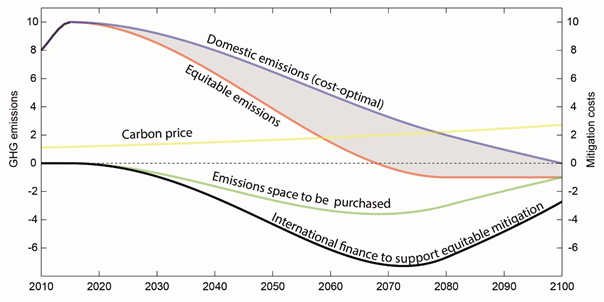
Figure 1 | Schematic figure for a (developed) country where the equitable scenario (red) is more stringent than the domestic one (blue). brTo achieve the equitable scenario at least costs, that country can support the corresponding emissions reduction (green) through international finance (black) possibly informed by a given price (yellow).
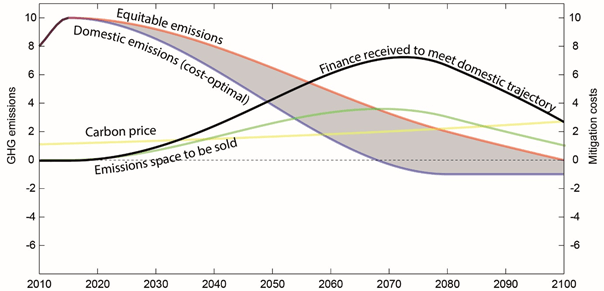
Figure 2 | Schematic figure for a (developing) country where the equitable scenario (red) is less stringent than the domestic one (blue). To fund the stringent domestic scenario at least costs, that country can implement mitigation beyond its equitable scenario (green) funded by international support (black) possibly informed by a carbon price (yellow).
Land-use emissions
Emissions of land-use (Land use, land-use change, and forestry - LULUCF) are included in the quantification of global warming but are not assessed as part of countries NDCs. Land-use emissions are not considered by all parties as part of the emissions scope to be negotiated. Moreover, no universal accounting method of positive or negative LULUCF emissions is currently in place. Therefore, LULUCF emissions were excluded from the global scenarios before allocating their emissions across countries. As a result, the ambition (or lack of ambition) on deforestation is not accounted here.
How much global warming is each pledge aligning with?
The Pledged Warming Map provides an assessment of global warming when all countries follow the ambition of a given one. This warming assessment assumes a self-interested approach of equity where each country follows the least stringent of three equity concepts (historical responsibility, capacity to pay and equality). This warming assessment reconciles the bottom-up architecture of the Paris Agreement with its top-down warming threshold.
Why using the Pledged Warming map?
With the Paris Agreement, countries committed to collectively limit global warming to well below 2 °C and pursue efforts to limit warming to 1.5 °C above preindustrial levels. However, there is currently no commonly agreed effort-sharing mechanism to determine the contribution of each country. Measuring the ambition of the climate pledges, the Nationally Determined Contribution (NDC), requires considerations of effort-sharing driven by equity concepts and countries are requested to provide in their NDC a description of how their contribution is ‘fair and ambitious’ (these are provided under the country graphs).
The international community has long discussed the operationalization of equity following the UNFCCC principle of Common But Differentiated Responsibilities and Respective Capabilities (CBDR-RC) to drive effort-sharing and derive national emissions allocations. The failure to agree on a top–down mechanism to derive binding national emissions targets for all countries led to a bottom-up situation where countries should pledge NDCs of highest possible ambition.
The first submissions of these bottom-up NDCs do not add up to a global ambition consistent with the joint temperature goals. A five-year stocktake, starting in 2020, requires all countries to pledge enhanced actions and support. The absence of agreement on a unanimous operationalization of the CBDR-RC should not be used as an excuse for inaction and should not leave the international community without a metric reflective of current agreements to assess the ratcheting-up process.
How to use these results of the Pledged Warming Map?
Taking stock of NDCs and ratcheting-up ambition
The warming metric used in this website relies on a combination of equity concept where each country follows the least-stringent equity approach (from capability, historical responsibility or equality). This hybrid combination reflects the bottom-up pledge-and-review architecture of the Paris Agreement provides a warming assessment of countries’ NDCs. The results can inform the ratchetting-up process on the ambition of current emissions targets without hypothesizing an international agreement on a single approach of equity. The emissions trajectories can be used by experts and decision makers to derive emissions targets in line with the Paris Agreement mitigation goals.
Climate cases
This hybrid combination of countries’ least-stringent equity approaches is also relevant to climate cases where the court only rules for the least-ambitious end of an equity-based range.
The multiplicity of equity concepts results in a wide range of emissions allocations for countries and regions that is sometimes used as an uncertainty range by non-experts. In a recent climate case, the District Court of The Hague ruled that the Dutch government has to reduce 2020 emissions to at least the least-ambitious end of the range recommended by the IPCC-AR4 for the Annex I country group based on multiple equity allocations from 16 studies. The court did not pick an approach of equity and ruled for the minimum effort consistent with international treaties in light of commonly reviewed science. While the multiplication of climate litigations cases against governments can contribute to the ratcheting-up process, systematic court decisions that governments must follow the least-ambitious end of an equity range would be insufficient to achieve the Paris Agreement. The trajectories presented here follow the least-stringent equity concept for each country individually but are collectively consistent with the Paris Agreement warming thresholds. Using the trajectories presented here to derive emissions target and phase-out dates enables to conform with the ambition of the Paris Agreement without selecting and applying a universal concept for all countries.
More information in the underlying peer-reviewed study.
